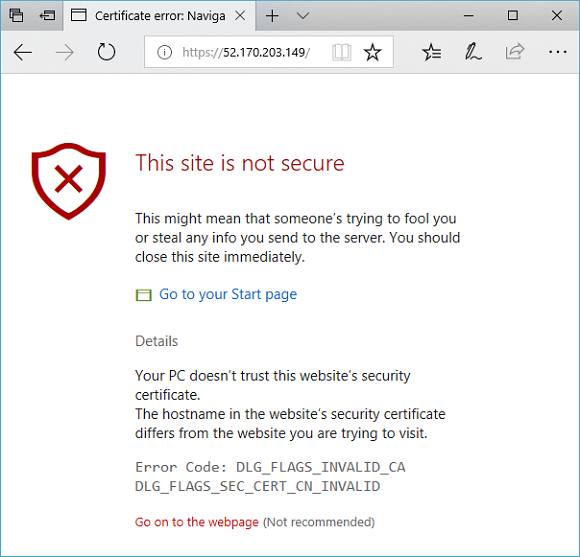可以通过 Azure CLI 使用 TLS 终端的证书创建应用程序网关。 对于后端服务器,可以使用虚拟机规模集。 在此示例中,规模集包含两个添加到应用程序网关的默认后端池的虚拟机实例。
在本文中,学习如何:
- 创建自签名证书
- 设置网络
- 使用证书创建应用程序网关
- 使用默认后端池创建虚拟机规模集
如果需要,可以使用 Azure PowerShell 完成此过程。
如果没有 Azure 订阅,可在开始前创建一个试用帐户。
先决条件
如需在本地运行 CLI 参考命令,请安装 Azure CLI。 如果在 Windows 或 macOS 上运行,请考虑在 Docker 容器中运行 Azure CLI。 有关详细信息,请参阅如何在 Docker 容器中运行 Azure CLI。
如果使用的是本地安装,请使用 az login 命令登录到 Azure CLI。 若要完成身份验证过程,请遵循终端中显示的步骤。 有关其他登录选项,请参阅使用 Azure CLI 登录。
出现提示时,请在首次使用时安装 Azure CLI 扩展。 有关扩展详细信息,请参阅使用 Azure CLI 的扩展。
运行 az version 以查找安装的版本和依赖库。 若要升级到最新版本,请运行 az upgrade。
- 本教程需要 Azure CLI 版本 2.0.4 或更高版本。
创建自签名证书
为供生产使用,应导入由受信任的提供程序签名的有效证书。 对于本文中的情况,请使用 openssl 命令创建自签名证书和 pfx 文件。
openssl req -x509 -sha256 -nodes -days 365 -newkey rsa:2048 -keyout privateKey.key -out appgwcert.crt
输入对证书有意义的值。 可接受默认值。
openssl pkcs12 -export -out appgwcert.pfx -inkey privateKey.key -in appgwcert.crt
输入证书的密码。 在此示例中,使用了 Azure123456!。
创建资源组
资源组是在其中部署和管理 Azure 资源的逻辑容器。 使用 az group create 创建资源组。
以下示例在“chinanorth2” 位置创建名为“myResourceGroupAG” 的资源组。
az group create --name myResourceGroupAG --location chinanorth2
创建网络资源
使用 az network vnet create 创建名为 myVNet 的虚拟网络和名为 myAGSubnet 的子网。 然后,可以使用 az network vnet subnet create 添加后端服务器所需的名为 myBackendSubnet 的子网。 使用 az network public-ip create 创建名为 myAGPublicIPAddress 的公共 IP 地址。
az network vnet create \
--name myVNet \
--resource-group myResourceGroupAG \
--location chinanorth2 \
--address-prefix 10.0.0.0/16 \
--subnet-name myAGSubnet \
--subnet-prefix 10.0.1.0/24
az network vnet subnet create \
--name myBackendSubnet \
--resource-group myResourceGroupAG \
--vnet-name myVNet \
--address-prefix 10.0.2.0/24
az network public-ip create \
--resource-group myResourceGroupAG \
--name myAGPublicIPAddress \
--allocation-method Static \
--sku Standard \
--location chinanorth2
创建应用程序网关
可以使用 az network application-gateway create 创建应用程序网关。 使用 Azure CLI 创建应用程序网关时,请指定配置信息,例如容量、sku 和 HTTP 设置。
将应用程序网关分配给之前创建的 myAGSubnet 和 myAGPublicIPAddress。 在此示例中,在创建应用程序网关时将关联所创建的证书及其密码。
az network application-gateway create \
--name myAppGateway \
--location chinanorth2 \
--resource-group myResourceGroupAG \
--vnet-name myVNet \
--subnet myAGsubnet \
--capacity 2 \
--sku Standard_v2 \
--http-settings-cookie-based-affinity Disabled \
--frontend-port 443 \
--http-settings-port 80 \
--http-settings-protocol Http \
--priority "1" \
--public-ip-address myAGPublicIPAddress \
--cert-file appgwcert.pfx \
--cert-password "Azure123456!"
创建应用程序网关可能需要几分钟时间。 创建应用程序网关后,可以看到它的这些新功能:
- appGatewayBackendPool - 应用程序网关必须至少具有一个后端地址池。
- appGatewayBackendHttpSettings - 指定将端口 80 和 HTTP 协议用于通信。
- appGatewayHttpListener - 与 appGatewayBackendPool 关联的默认侦听器。
- appGatewayFrontendIP - 将 myAGPublicIPAddress 分配给 appGatewayHttpListener。
- rule1 - 与 appGatewayHttpListener 关联的默认路由规则。
创建虚拟机规模集
在此示例中,将创建虚拟机规模集,以便为应用程序网关的默认后端池提供服务器。 规模集中的虚拟机与 myBackendSubnet 和 appGatewayBackendPool 相关联。 若要创建规模集,可以使用 az vmss create。
az vmss create \
--name myvmss \
--resource-group myResourceGroupAG \
--image Ubuntu2204 \
--admin-username azureuser \
--admin-password Azure123456! \
--instance-count 2 \
--vnet-name myVNet \
--subnet myBackendSubnet \
--vm-sku Standard_DS2 \
--upgrade-policy-mode Automatic \
--app-gateway myAppGateway \
--backend-pool-name appGatewayBackendPool
安装 NGINX
az vmss extension set \
--publisher Microsoft.Azure.Extensions \
--version 2.0 \
--name CustomScript \
--resource-group myResourceGroupAG \
--vmss-name myvmss \
--settings '{ "fileUris": ["https://raw.githubusercontent.com/Azure/azure-docs-powershell-samples/master/application-gateway/iis/install_nginx.sh"],
"commandToExecute": "./install_nginx.sh" }'
测试应用程序网关
若要获取应用程序网关的公共 IP 地址,可以使用 az network public-ip show。
az network public-ip show \
--resource-group myResourceGroupAG \
--name myAGPublicIPAddress \
--query [ipAddress] \
--output tsv
复制该公共 IP 地址,并将其粘贴到浏览器的地址栏。 就此示例来说,URL 为 https://52.170.203.149 。

若要接受有关使用自签名证书的安全警告,请依次选择“详细信息”和“继续转到网页”。 随即显示受保护的 NGINX 站点,如下例所示:

清理资源
当不再需要资源组、应用程序网关以及所有相关资源时,请将其删除。
az group delete --name myResourceGroupAG --location chinanorth2